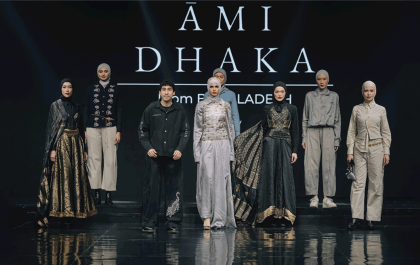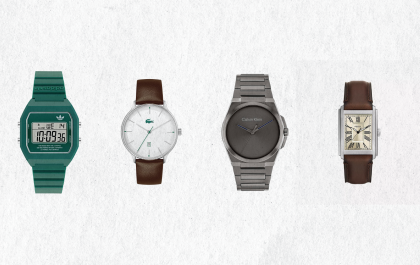The intricate interplay between art and horology transforms watch dials into captivating canvases, reflecting aharmony between timekeeping and artistic expression
By Gaurav Mehta
Artistic movements, from Art Deco to Modernism, have profoundly influenced watch design. Watch dials are horological real estate on which art flourishes. The Art eco Movement, which began post World War I, gave us watches with slightly rounded edges, representative of its design aesthetics.
The Girard-Perregaux Vintage 1945 XXL Large Date and Moon Phase drew inspiration from the Art Deco movement’s design language. Another famous Art Deco inspired watch, Jaeger-LeCoultre Reverso, features signature geometrical lines, emblematic of the design movement. Jaeger-LeCoultre also paid tribute to Vincent van Gogh, adorning the dials of special-issue Reversos with painstakingly rendered enamel reproductions of his works. Reversos also celebrated other art luminaries such as Seurat, Xu Beihong, and Ferdinand Hodler.
The German Bauhaus Art Movement influenced brands such as Movado. Its Museum Watch, which was first designed in 1947 by American designer Nathan George Horwitt, led to the creation of a singular design element that, today, has become Movado’s signature—a circle at 12 o’clock that represents the sun at its strongest. It now lies in New York’s Museum of Modern Art’s permanent collection.
Some years ago, Hublot collaborated with French artist Marc Ferrero for the Big Bang One Click Marc Ferrero watches. The artist is known for the use of graphic images, predominantly from the 70s. The two watches emanating from this collaboration feature Marc Ferrero’s iconic work ‘Lipstick’ on the dial. Available in pink and turquoise, the watches’ bezels are studded with 42 red spinels or blue topazes.
Hublot has worked with Takashi Murakami, Richard Orlinski, and Shepard Fairey, among others, on limited-edition reinterpretations of the brand’s iconic timepieces. Among their Murakami watches is one with a transparent sapphire-crystal case and a rotating smilingflower-motif dial executed with 384 coloured gemstones, which costs £88,000.
At Jaipur Watch Company, we recently collaborated with the Palace of Kilimanoor’s Temple of Art. Kilimanoor Palace was home to one of India’s greatest artists, the modernist Raja Ravi Varma. Though Raja Ravi Varma is known for his academic and realistic style of painting, he sought to break the artistic code of his time when paintings of Gods and Goddesses were inspired by temple sculptures. The depiction of gods and goddesses in modern India through their portraits that find place in our home temples, or through the pages of comic books such as Amar Chitra Katha, are part of Raja Ravi Varma’s legacy.
My desire to explore divinity images in watches took me to Raja Ravi Varma’s art. When we surveyed how much Indians know about him, we found, to our surprise, that almost 70% of the current generation was unaware of him and his work. The realisation sparked the idea of developing a world-class watch collection based on the paintings For artists, watches have often been objects d’art and even subjects of their art. The most famous, of course, was the 1931 work by Salvador Dali, The Persistence of Memory, which is now in the collection of Museum of Modern Art and oleographs of Raja Ravi Varma. It is our way to connect with his legacy and India’s art heritage, infusing classical art into modern watch making.
HOROLOGICAL WORLD AS A MUSE
The synergy between the worlds of horology and art has never been a one-way street. Meticulous craftsmanship involved in watch- making has inspired artists. The precision of movements and philosophical concept of time are often reflected in various art forms, creating a two-way street of inspiration between these disciplines. Many of the 20th century’s biggest artists owned huge art collections. Picasso had a collection that included a Rolex GMT-Master, a Jaeger-LeCoultre Triple Date Moonphase, and a Patek Philippe Triple Date Moonphase. Andy Warhol owned a collection of 313 watches, including Rolex, Patek Philippe, Piaget, and Cartier.
For artists, watches have often been objets d’art and even subjects of their art. The most famous, of course, was the 1931 work by Salvador Dali, The Persistence of Memory, which is now in the collection of Museum of Modern Art. By depicting a highly complex mechanical object in a gelatinous, melting form, Dalí was making a statement about how irrelevant industrial society’s obsession with time is. In his 1980 triptych, artist Richard Prince presents a series of rephotographed luxury watch ads recontextualised as a sort of altar.
The fusion of art and horology goes beyond mere aesthetics; it’s a celebration of human creativity. At Jaipur Watch Company, through our artistic collaborations, we exemplify how every second can be a testament to this enduring partnership between art and time.
The author is the founder-CEO of Jaipur Watch Company
Reproduced with permission from Mansworldindia.com
- mwhttps://mansworldbangladesh.com/author/mw/
- mwhttps://mansworldbangladesh.com/author/mw/
- mwhttps://mansworldbangladesh.com/author/mw/
- mwhttps://mansworldbangladesh.com/author/mw/













